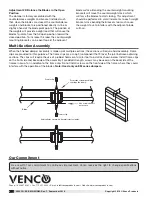
Counterbalance Adjustment
Procedure
The following instructions should be followed when
attempting to maximize the counterbalance effect
on the EM or GM model dampers. Be aware that
when the balance setting is highly sensitive, friction
wear, and contamination will have an adverse effect
to the operation of the damper. The sensitivity of
the counterbalance should only be set to meet the
application requirements. The damper must be mounted
square and plumb and operate freely before any weight
adjustments are performed.
Counterbalance Adjustment for EM/
ES/GM-30, 31, and 32 Models: Vertical
Mount - Horizontal Airflow
There are two different adjustments that can be made:
Adjustment #1: affects the balance of the
blades in the open position. Use this adjustment
method if the damper blades do not achieve full
open position under airflow and you want them
to open further or all the way.
Adjustment #2: affects the balance of the blades
in the closed position along with a small change
to the open position balance.
If the airflow through the damper is light and the blades
only slightly move from the closed position, then
Adjustment #1 and #2 are required.
Adjustment #2: Balance the Blades in the Closed
Position
The damper is assembled with the counterbalance
weights and bracket installed such that, when the
blades are closed, the counterbalance weights and
bracket are positioned directly in-line with the blade
pivot points. This position of the weights will provide a
light load that will hold the blades in the closed position.
To reduce this load, the counterweight mounting
brackets can be bent away from the adjacent blade
surface. Bending the counterweight mounting brackets
will move the counterweight stack behind the blade
pivot point and therefore allow the blades to start
opening at lower airflow rates. This adjustment should
be performed in small increments since the blades will
not fully close if the brackets are bent too far.
Adjustment #1:Balance the Blades in the Open
Position
Moving the weight stack along the length of the
mounting bracket slot will affect the full open balance
of the blade assembly. Moving the weights further
away from the blade pivot point will cause the blades
to become more balanced so that at some point, and
with enough weight, the blades would remain open.
Care must be taken to ensure that when the weights
are moved outward from the blade pivot point they will
not interfere with the adjacent blade when the blades
close. Moving the weights back towards the blade pivot
point will allow the blades to close. If the damper blades
do not open completely and Adjustment #1 has been
addressed, then more weight is required.
4) Damper must be installed into duct or opening square
and free of twist or other misalignment. Damper
must not be squeezed or stretched into duct or
opening. Out of square, racked, twisted or misaligned
installations can cause excessive leakage and/or
torque requirements to exceed damper/actuator
design.
5) Damper and actuator must be kept clean, dry and
protected from dirt, dust and other foreign materials
prior to and after installation. Examples of such
foreign materials include but are not limited to:
a)
Mortar dust
b)
Drywall dust
c)
Firesafing materials
d)
Wall texture
e)
Paint overspray
6) Damper should be sufficiently covered as to prevent
overspray if wall texturing or spray painting will
be performed within 5 feet (1.50m) of the damper.
Excessive dirt or foreign material deposits on
damper can cause excessive leakage and/or torque
requirements to exceed damper/actuator design.
7) ACCESS: Suitable access (actuators maintenance,
etc.) must be provided for damper inspection and
servicing. Where it is not possible to achieve sufficient
size access, it will be necessary to install a removable
section of duct.
Bend counterweight mounting
bracket away from blades.
Bend Here
ES EM GM Series
2






